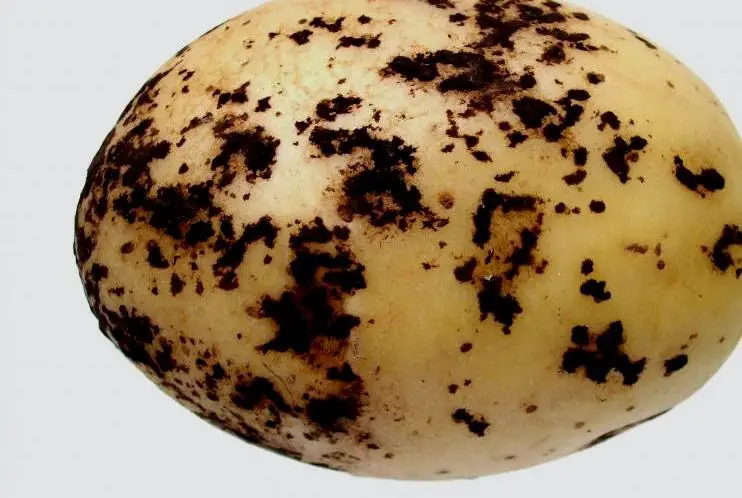We use affiliate links to run our site. When you buy through links on our site, we may earn an affiliate commission, without any added cost to you. Learn more
Potatoes are prone to many diseases. But if you are aware of them and take precautionary measures you can grow potatoes in your home without any problems.
Here in this post, we will share some valuable information about some of the most common potato diseases, how to identify them, and also, how to prevent them from damaging your potato plants.
9 Deadliest Potato Diseases
1. Potato Wart:
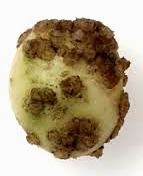
Pathogen:
It is one of the most dreaded diseases of potatoes. Potato wart disease is caused by the soil-borne fungus Synchytrium endobioticum. The spores of the fungus can remain viable in contaminated soil for many years.
Symtopms:
- In this case, potatoes grow swelling or tumors.
- Sometimes you will find more than one tumors in the tubers.
- The eyes develop into characteristic warty, cauliflower-like swellings.
- Infected tubers turned into warty mass and turn black with age.
Prevention and Care:
The best way to control potato wart disease is to use immune varieties for growing potatoes.
2. Bacterial Wilt:
Pathogen:
A soil-borne bacterium named Ralstonia solanacearum causes this disease in potatoes. The bacterium enters into the body of the plant through open wounds in roots.
Other than potatoes this also affects plants like chili, tomato, tobacco and egg plants. The disease spreads from field to field or from plant to plant within field via infected seed, air, water, soil, gardening tools, etc
Symptoms:
- The symptoms of bacterial wilt are visible on all parts of infected plants.
- It stats to wilt, from the tips of the leaves or where the stems branch out, and then spreads to all parts of the plant.
- Leaves become yellow at their bases.
- If you cut the tubers in half you would find black or brown rings or white to brown pus.
- Sometimes fluids might come out of tuber eyes. Serious infection can cause the tubers to rot.
Prevention and Care:
- Use certified seed from reliable sources.
- Use crop rotation with pastures, cereals and non-solanaceous crops for periods of more than 5 years.
- Clean garden tools with a disinfectant solution after use.
3. Common Scab Disease:
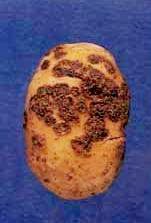
Pathogen:
Common scab is a bacterial infection caused by Streptomyces scabies. It enters the tubers through the lenticels (the pores in the tuber skin) or through wounds.
Being a bacterial infection the disease usually spreads through contaminated soil, seed and water.
Scab is much more destroying if the soil is alkaline.
Symptoms:
- It makes the tissue corky to the surface.
- Infected tubers show rough, cracked skin, with scab-like spots. If the plant is affected severely, the skin gets covered with rough black welts.
Prevention and Cure:
- Do not add lime to the soil. You can reduce the alkalinity of the soil by using these steps.
- For better results, use resistant varieties of the plant.
- Keep the moisture level in the soil by watering frequently. But excessive irrigation may also spread the disease, so keep an eye on that too.
- Rotate to small grains or alfalfa.
- In the common scab disease, the infections are mostly superficial and you can eat the tubers.
4. Late Blight Disease:
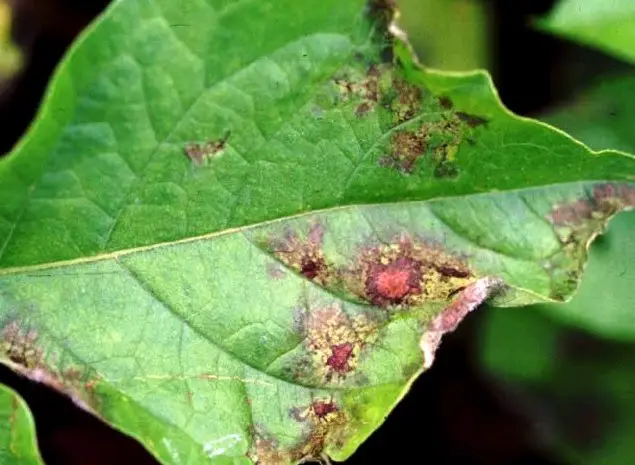
Pathogen:
The late blight disease is caused by a fungus-like organism Phytophthora infestans. The pathogen survives in plant debris in the soil and spreads mainly through the soil and infected seed tubers.
The pathogen becomes highly active in humid conditions, low temperature and leaf wetness.
Symptoms:
Late blight is one of the most important potato diseases. It mainly damages leaves, stems and tubers.
- Affected leaves of the plant wilt and turn brown within weeks. Sometimes, spots appear on the underside of leaves.
- The stems become black from the tips and dry out eventually.
- Infected tubers have dry brown-colored spots on their skins and flesh.
Prevention:
Late blight disease can be fatal to the plants. So take immediate steps
- Destroy or bury all crop debris and tubers at the end of each season.
- Use disease-free varieties of seed potatoes to grow the plants.
- Use a thick layer of mulch to prevent tuber infection.
- Irrigate early in the day to allow leaves to dry before night.
5. Early Blight Disease:
Pathogen:
This potato disease is caused by a fungus called Alternaria solani. It can survive winter in infected plant debris, or on the soil and can infect plants after several years. They love warm, humid weather and can become deadly during this period.
Symptoms:
- The disease can occur at any stage of the growth and causes characteristic leaf spots and blight.
- Initially, it appears as small, black lesions on the older foliage. With time these enlarge and form concentric rings in a bull’s eye pattern.
- Tissue surrounding the spots may turn yellow. In a favorable condition the fungus can kill most of the foliage.
Prevention and Control:
Use cover crops prior to planting potatoes. Also, use crop rotations techniques.
6. Canker Stem Disease:

Pathogen:
The canker stem or the black scurf disease is caused by fungus names Rhizoctonia solani. The fungus is soil-borne and attacks roots and tubers. Usually, when stolons contact soil-borne fungal bodies, the plant gets infected.
In Warm humid conditions, Rhizoctonia becomes most active.
Symptoms:
- The most common symptoms of these potato diseases are irregular lumps of tubers.
- The infection can also spread to the roots. Black lesions on roots are very common in canker disease.
- Black dirt like fungal structures, called sclerotia, develop on tubers. These are dirt like appearance won’t wash off.
Prevention and Cure:
One of the solutions suggested is to use crop rotation. 1 or 2 years of crop rotation may help reduce the problem.
7. Black Leg and Soft Rot
Pathogen:
Black leg or soft rot disease in potatoes is caused by the bacteria Erwinia spp. It infects potato seed pieces during cutting and handling. The bacteria can survive winter in crop debris on the soil surface and become mostly virulent when the weather is warm and humid.
Symptoms:
- Potatoes that grow from infected seed pieces develop a black soft decay. Tubers from the nearby plants also get infected.
- Soft rot starts to occur inside the tubers. The cell walls dissolve and the tuber gets liquefy inwards.
- You won’t find any distinct smell from the rot.
Prevention and Cure:
- Keep seed tubers at 10-13 deg C during storage and after cutting. Provide good ventilation.
- Clean cutting knives and tools frequently.
- Make sure the callus is formed on the seed potatoes before you plant them.
8. Dry Rot Disease:
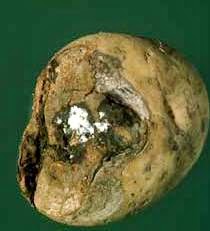
Pathogen:
This dry rot is caused by Fusarium species.
Symptoms:
- The potato skin becomes brown, or even darker, and develops wrinkles.
- Internally, infected areas are light brown to black as the fungus kills the cells of the tuber.
- The infected areas although remain dry, in humid conditions bacteria can cause foul-smelling wet infections. Remove the infected areas as soon as possible or else the tuber can completely rot and shrivel.
Prevention:
It is more or less to do with the storage problem. You need to be more careful while harvesting and storing potatoes.
9. Viral Diseases:
Followings are some of the most common potato viruses:
Potato virus Y (PVY ) is a Potyvirus, causes a stipple streak. The Symptoms can vary depending upon the strain and potato variety. But generally, you will find mosaic or necrotic reactions. Other than potatoes this virus can also affect tomato, pepper and other Solanaceae plants.
Potato virus S (PVS) is a Carlavirus, infected plants show a slight deepening of the veins, rough leaves, more open growth, mild mottling, bronzing, or tiny necrotic spots on the leaves.
Potato Virus X (PVX) is one of the most widely distributed viruses of potatoes. Plants often do not exhibit any symptoms, but sometimes the virus can cause symptoms like chlorosis, mosaic, decreased leaf size, and necrotic lesions in tubers.
Alfalfa Mosaic Virus (AMV) infects more than 150 types of plants. They are spread by aphids. Generally, the effect is not very severe in potatoes.
Potato leafroll virus (PLRV) causes an important disease of potatoes. After infection, the upper leaves become pale, upright, and rolled and show some reddening. PLRV can be difficult to detect as foliar symptoms are not always obvious.
Most of the virus is transmitted through Aphids. Control aphid populations using these 12 organic methods to prevent the spread.
Common Potato Pests
Slugs and Snails:
Several snails and slugs love to chew the leaves and tubers of the potato plant. They create holes in the tubers. The attack is especially severe in the rainy season.
- Don’t water in the evening.
- Check for visible pests and remove them manually.
Root-knot Nematodes:
Root-knot nematodes attack the tubers. The damage is more like scabs only sometimes, the swellings become larger.
The probable solutions would be to rotate the crops and use green cover crops like mustard, rapeseed etc. And till them into the soil.
Things to Remember:
One of the most important steps you can take as a home gardener is to prevent the disease from happening. As you can see, many diseases are associated with the use of infected tubers for planting, the disease prevention starts with selecting healthy seed tubers.
Always purchase certified seed potatoes for planting. Using last year’s crop, or using potatoes from the grocery shops can create problems.
Tips and Tricks:
Here are some tips that will help you fighting potato disease:
- Never overwater your potato plants. Keep the soil moist but not soggy.
- Never plant potatoes and tomatoes near each other. If your tomatoes get some disease, it will transfer to the potatoes sooner than you expect. Here is a list of companion plants for potatoes.
- Remove infected or diseased plants from the garden.
- Remove all the debris of the potato plants from the garden after harvest the tubers.
Amazon and the Amazon logo are trademarks of Amazon.com, Inc, or its affiliates.
